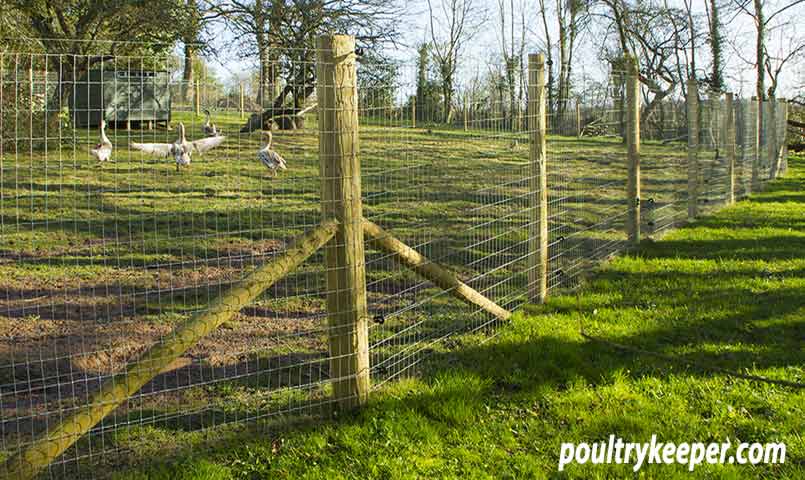
Poultry fencing isn’t often covered in poultry books, and yet it is a fundamental requirement to keep birds safe from predators. In this guide, I will cover fencing a fixed area off to use as a poultry run, rather than building or buying a small run that attaches to chicken coops.
All poultry need protection from predators, but depending on where you live in the world, the list of what you are protecting against will change. During my time keeping poultry, I have lived in England and Wales, and even this relatively small change in location has seen my list of potential predators change.
What are you protecting against?
In Wales, we had buzzards taking chickens from open spaces, and I lost several bantams to hawks. Our friends down the road had a stream running along the edge of their garden and had to trap mink that would come during the winter and take their ducks. In Bedfordshire, many foxes patrolled our fences, and now in Herefordshire, strangely, I hardly see a fox (probably because there are very few rabbits and pheasants?). Still, a badger will occasionally visit me and cause a lot of damage to some of my portable detachable runs. I have had magpies entering my chicken coops to steal eggs, and during winter, rats can be a problem unless I use rat-proof feeders and traps.
When you first start keeping poultry or move to a new area, it is best to develop a list of potential predators before building a fence because it’s more costly to change a fence afterwards.
While my experience and advice aim to keep your poultry safe in the UK, most of this applies to other countries. Still, obviously, if you’re keeping chickens elsewhere, such as the US, you may have to scale up the protection or make some modifications to your plans according to your local list.
Foxes
By far, the biggest predator problem for poultry in the UK is the fox. They are widespread, and often, urban foxes can be a bigger problem than rural foxes because they are scavenging and short on food. Unless you are fortunate enough to live on an island with no foxes (the Isle of Man, for example, has no foxes), I would always consider the fox your number 1 predator, and most poultry fencing should be designed to keep foxes out above everything else.
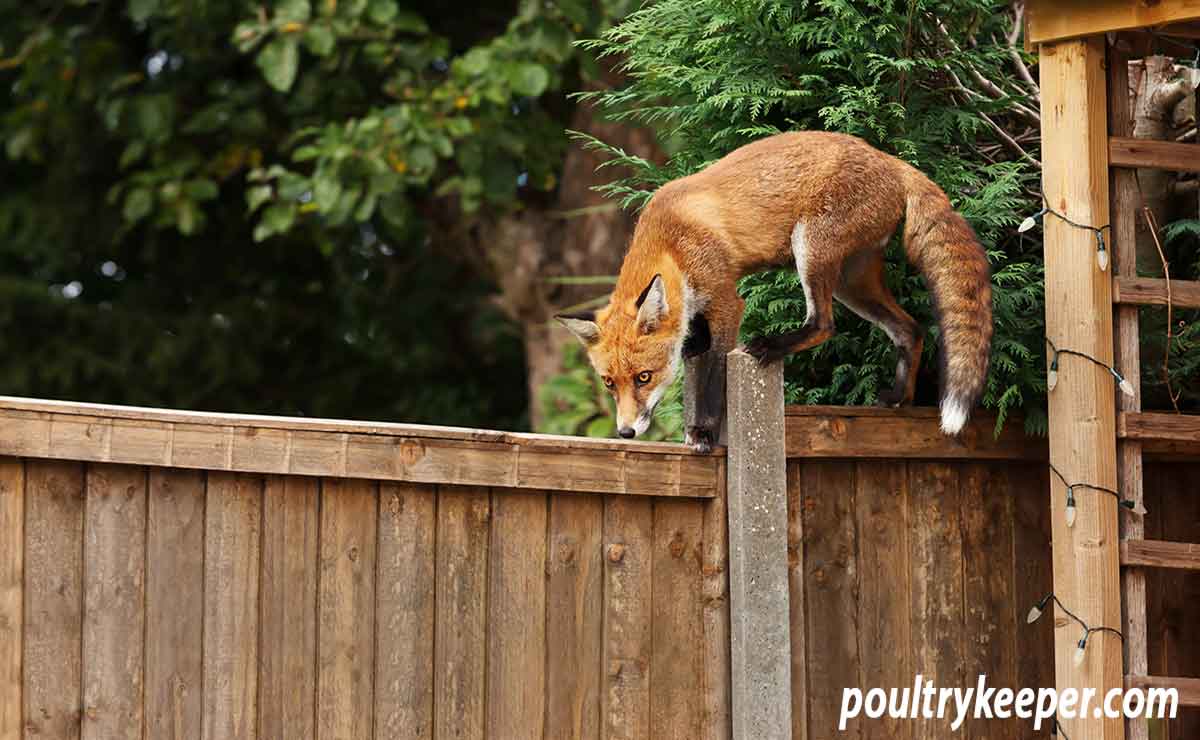
It’s horrible, even scary, when you discover a fox has visited your chicken coop. Foxes can be cruel to us as poultry keepers, and as well as the heartache of losing birds, there is also the financial loss.
When foxes are short of food or are feeding young, they will hunt during the daytime, and a determined fox, can run up and over a 5-foot fence if it has a rigid enough top.
Foxes (and badgers who are even better diggers) will easily dig a hole underneath a fence that isn’t buried or doesn’t have an electric wire to protect it.
Poultry Predators Section
Visit the poultry predators section to learn more about specific poultry predators and how to protect against them.
Poultry fencing to keep predators out
Once you have your list of potential predators and know what you’re up against, you can design your fence to keep these predators out!
You may notice I don’t mention fencing to keep poultry in. Keeping poultry in a run isn’t normally as much of a problem as keeping predators out of it.
Separating chickens, ducks or geese inside a secure run will usually only require low fencing. There are some exceptions; some light, flighty Mediterranean breeds can fly extremely well (Leghorns, for example), but you can keep the average hen behind a waist-high fence and clip a wing of any escapees that are determined to fly.
So, the job of poultry fencing is almost always to keep predators out and will, by default, almost always keep your birds in.
Designing a secure fence
There are a few things to consider when designing your fence. Predators that:
- Dig to get underneath.
- Climb or jump the fence to get over it.
- Can fit through the fence (in the case of larger mesh wire).
- Are strong enough to break through in some way.
While many people think foxes are similar to dogs (and in many ways, they are), their ability to climb and jump is more like a cat.
There are a few different types of fences you can construct to protect your birds. I have used all of these successfully.
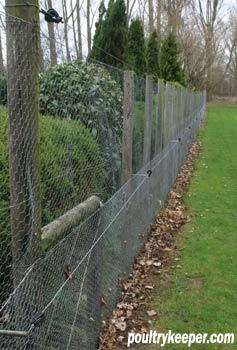
- Electric Poultry Netting – Which must not short out on anything such as long grass and is unsuitable to have where children play. It is useful to create secure poultry runs if you have a suitable area and can be moved around to provide your hens with fresh pasture.
- A low secure fence with the addition of a ‘Triple Wire’ – an electric wire at the bottom to stop digging, the middle and top to stop climbing. More information is coming up in “Fencing Larger Areas”.
- A secure fence that is tall and strong enough to stop predators physically will be discussed below.
As a general rule of thumb, all of my poultry fences use 8ft wooden posts with 2ft in the ground.
Secure poultry fencing
In order to stop foxes getting into a poultry run, the fence needs to be buried to stop digging and tall enough to stop jumping / climbing. The wire should be strong enough to stop tearing although with the quality of most chicken netting these days, it’s usually easier to double it up at the level where the predator will try to tear at the wire.
 The top of the fence
The top of the fence
To stop a large fox from running up and over a fence, it has to be at least 1.8 M (6ft) high. If you don’t want a fence this high then you can either turn the top outwards, or run a single electric strand along the top where it is at least out of reach of children but I wouldn’t consider a fence that’s lower than about 1.5 M (5ft) where there are foxes.
The bottom of the fence
Foxes will dig under a fence if the ground is soft enough. Badgers are very good diggers and can also rip at chicken netting to tear it. The bottom of a poultry fence, should have the wire buried 8-12 inches in the ground and then turned outwards by about 8. The length of wire you bury really depends on the type of soil and how level the ground is. Clay soils are the hardest to dig, sandy soils are very easy, so use some common sense when burying the netting. If it was easy for you to dig, it will be easy for a fox. Ideally put bricks / rubble on top of the turned out wire before covering it back over with soil.
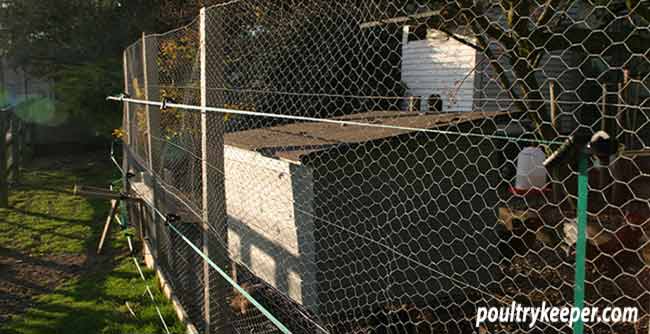 A 5ft poultry fence made from 50mm netting with electric tapes to stop foxes from climbing it.
A 5ft poultry fence made from 50mm netting with electric tapes to stop foxes from climbing it.
Badgers
If there is a problem with badgers taking poultry in the area then it is better to overlay an extra piece of netting at the lower level (i.e. a triple layer) in addition to the wire that is buried in the ground and overlapped at the bottom of the fence. This helps to stop badgers (which are incredibly strong) from tearing the wire. You may find that purchasing a small electric fencing kit and running a pair of electric wires on insulators around the run at the badger’s nose height is easier.
Patching up a fence
If you’re trying to patch up a fence, you may find boarding the bottom of it with gravel boards successful. This means a fox has to dig deeper before he can squeeze underneath it. I would still try to turn the wire out though, even if it means laying the wire on to the surface of a lawn for 24 inches and pegging it down. The grass will grow through the wire and the action of earth worms moving soil means that it will gradually sink beneath the surface of the grass and disappear from view.
Chicken netting
There are numerous suppliers of chicken netting. Farmers merchants tend to call this ‘rabbit wire’ since it is sold to fence fields of young saplings or other critical crops to prevent rabbits from getting in. The netting is usually 50mm across the widest part of the hole. It is hot dip galvanised to stop it from rusting.
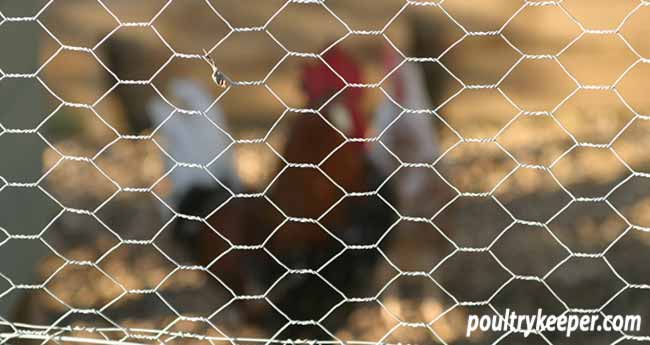
Not all chicken netting is equal! Some cheap netting tends to use thinner strands of wire and as well as coming in 10, 25 and 50 Meter lengths, they also come in various widths of 600 (2ft), 900 (3ft), 1200 (4ft) and 1800mm (6ft).
If you are going to bury the wire to stop foxes, remember to allow at least 450mm (18″) to go in the ground, plus the height of your fence.
When I am constructing my chicken fencing, I normally use two 4ft lengths of chicken netting that is overlapped by 150mm (6″) and woven with a single galvanised strand of fencing wire at the join. This gives enough height to bury the wire and provide either a 6ft fence or 5ft fence with outward overhang.
You can buy chicken netting at agricultural merchants, or it’s possible to order it online which is usually cheaper. There is a list of suppliers here from the Amazon Marketplace (UK and US).
Portable chicken netting
If there isn’t a fox problem, or you are looking for a movable netting solution then the Omlet Chicken Netting works really well. This will not keep foxes out. however, it can keep your chickens in a given area (or off a given area such as a vegetable patch). I tested and reviewed this here: Omlet Chicken Netting.
Locking up at night
As I have seen written on the side of many a fencing contractor’s vans “your fence is your first line of defence” and they are words that ring true, especially where poultry are concerned.
The second line of defence you have of course is your chicken coop. Predators will be able to spend longer under the cover of darkness trying to get into your run and if they do, should then be thwarted by a secure coop.
ALWAYS lock your chickens up at night. If you are sometimes late getting home, or forget to go out to lock them up as it gets dark, consider an automatic door closer which will automatically close the pop hole once it is dark and your chickens are safely inside.
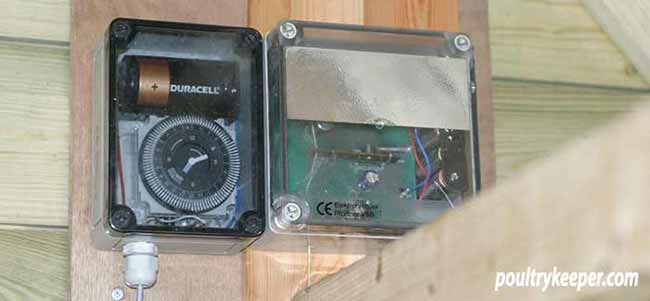 This VSB automatic door is fitted inside my coop and closes the pop-hole at dusk.
This VSB automatic door is fitted inside my coop and closes the pop-hole at dusk.
Fencing larger areas
Low fences with electric wires on the outside can be installed around larger areas. Whilst a fox can easily jump a 1m fence or run up and over a 1.5m fence, he will normally investigate a fence first to find the easiest way to cross it. In doing so, an electric wire at nose height will usually get touched.
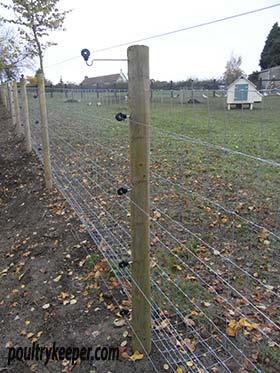
Most foxes only need to touch this once and receive a shock (which is in fact an unpleasant feeling due to the muscles contracting and is not harmful) and then will not attempt to cross the fence in future.
Electric wires are normally placed at the top of the fence to stop climbing, the middle at fox nose height (the most likely one to be touched) and at the bottom to prevent digging.
Pig/sheep fencing is the cheapest to have installed by a contractor but it is a little low so needs additional electrified wires adding to the top and as well as a wire at fox nose height requires one a few inches from the ground to stop digging. Any grass touching this lower wire will leak current to earth and wet grass will soon short the fence out, making it ineffective so you will need to keep clearing the grass underneath.
Tundra produce a good range of wires that will last a lifetime. Their commercial poultry wire (part number LHT15/158/8) folds at the bottom to stop digging and has a finished height of 1.25m. This means the lower electric wire doesn’t need to be as close to the ground, making it easier to maintain and by the time the fence is finished with a top wire, gives an overall height of 1.3m. The photo to the right shows this wire which in this installation shows the wire turned inwards rather than out. The grass eventually grows through the wire locking it in place.
Chicken netting may be required along the bottom of the fence if you plan on raising chicks or ducklings since youngsters can get stuck between the lower squares of wire.
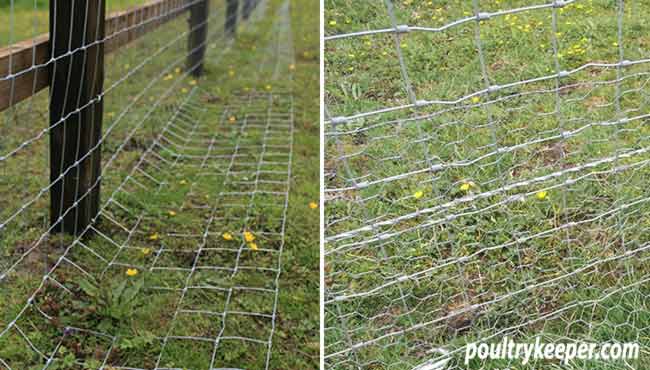
Left: The grass will grow through and the wire disappears. Right: Young chickens and ducklings get stuck in the squares so smaller chicken wire should be added along the bottom.
Whilst this approach is suitable for a larger enclosure than most would want, if you’re going to the expense of fencing a field or paddock where your chickens will free range, it doesn’t cost much more to use this kind of wire, which for me, provides peace of mind.
Do you have any fencing tips? How high is your chicken fence and does it stop foxes? Please let me know below.


 The top of the fence
The top of the fence

